
Xiaomi A1 is really a great release by Xiaomi this year. It's the first smartphone that doesn't come up with Xiaomi official UX, MIUI. It is also the first device that is the result of a reboot of Google’s Android One program— an initiative that saw little success in its first phase in India. In this review, I’ll take a deep dive into Xiaomi A1. Before getting started, let’s take a look at the specification sheet.
Device Name: Xiaomi Mi A1Release Date/Price: Available Now, ₹14,999 ($230)Android Version: 7.1.2 Nougat (Android One)Display: 5.5 inch 1080p IPS LCD (401p ppi)Chipset: Snapdragon 625, Octa Core Cortex-A53, 8x 2GHz, Adreno 506 GPUBattery: 3,080mAh non-removableRAM: 4GB LPDDR3Sensors: Fingerprint, Accelerometer, Gyroscope, Proximity, Ambient Light, Electronic CompassStorage: 64GB eMMCConnectivity: USB 2.0 Type-C, Hybrid SIM tray (Micro SIM + Nano SIM or Micro SIM + Micro SD card), 3.5mm audio jack, IR BlasterDimensions: 155.4 x 75.8 x 7.3 cm (~70.1% screen-to-body)Rear Camera: Dual 12MP, PDAF, 4K@30FPS / 720p@120FPS videoWide Angle: f/2.2Telephoto: f/2.6, 2x optical zoomWeight: 165gFront Camera: 5MP, Fixed Focus, 1080p@30FPS video
Design
The Xiaomi Mi A1, like several other Xiaomi phones and phones from other Chinese OEMs, borrows several elements from Apple’s iPhone 7 Plus when it comes to design. But instead of being a straight-up lifting of the iPhone 7 Plus, the Mi A1 blends in the antennae design and the camera layout from the iPhone with a carcass that feels similar to the Xiaomi Redmi Note 4 due to its boxy outlines. The side frame of the device is fairly flat, and the transition curve from the sides to the flat back is fairly steep. But unlike the Redmi Note 4 and other previous phones which had plastic caps on the back, the Xiaomi Mi A1 is an actual metallic unibody device, giving it a rich feel in the hand.

The antennae bands run close to the edges on the back of the device, similar to what we now see on a lot of other phones. The dual rear camera setup sits on the right of the dual-tone LED flash, which gives it a differentiating feature from the iPhone look (as the iPhone has the camera setup on the left of the LED). The fingerprint sensor sits on the central axis of the back and is placed towards the top. The bottom of the back bears the Mi branding, the Android One branding and other regulatory branding — there’s a substantial amount of text and symbols here. The camera bump is tall and it’s sometimes difficult to ignore as most of Xiaomi’s previous devices usually had a flush camera setup and used the thickness to squeeze in battery — in this device, it’s the opposite, and we are not very excited about that. The bottom of the device is quite busy as it houses several openings like the 3.5mm headphone jack, the primary microphone, the screws that hold the phone shut, the USB Type C port and a set of drilled holes for the speaker. The top of the device houses only the IR Blaster and the secondary microphone for noise cancellation. The left of the device houses the hybrid SIM tray.
Performance
The Xiaomi Mi A1 comes with the tried-and-tested Qualcomm Snapdragon 625 SoC, a mid-range SoC that boasts of a good mix between power efficiency and performance. Built on a 14nm fabrication process, the Snapdragon 625 packs 8 Cortex-A53 cores with a peak clock speed of 2GHz. This lays the foundation for the Mi A1 to come up as an efficient mid-range device on paper, much like the Redmi Note 4.
Cpu and System
GeekBench, a benchmark that helps assess CPU performance, gives the Xiaomi Mi A1 a score of 877/4204. This surprisingly beats not only the Redmi Note 4, but the Redmi Note 3 as well on its multi core performance. BaseMark OS II, which measures performance through various calculations and transformations, gives the Mi A1 a total score of 1241, with the Mi A1 scoring higher on system performance than the Redmi Note 4. Individual benchmark numbers mean very little by themselves, but the overall trend with the benchmark scores places the Mi A1 firmly in the mid end segment, behind the flagships like the 835 and 821 and upper mid end SoCs like the 660. PCMark, which takes a holistic approach to benchmarking by putting the device through common real-world scenarios in a less-discrete testing environment, scored the Mi A1 at 4753, which is similar to what the Redmi Note 4 managed to score.
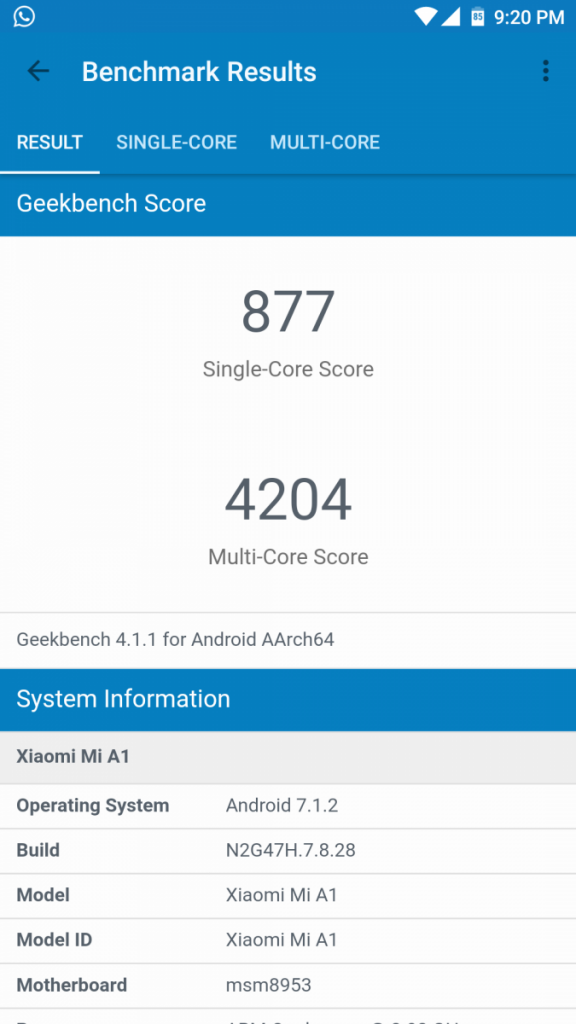
Much like the Xiaomi Redmi Note 4, the Xiaomi Mi A1 is a phone that does not make you feel that you are not holding a premium dollar device in your hand as far as performance is concerned. While one can find a few performance quibbles, mainly with how lethargic the stock animation speed even on this stock Android device is (seriously, why are all animations not sped up on stock Android? Most SoCs can work well with the faster speeds), and how apps still have a small but noticeable delay in opening up, most consumers will very likely never notice any of these in their daily usage.
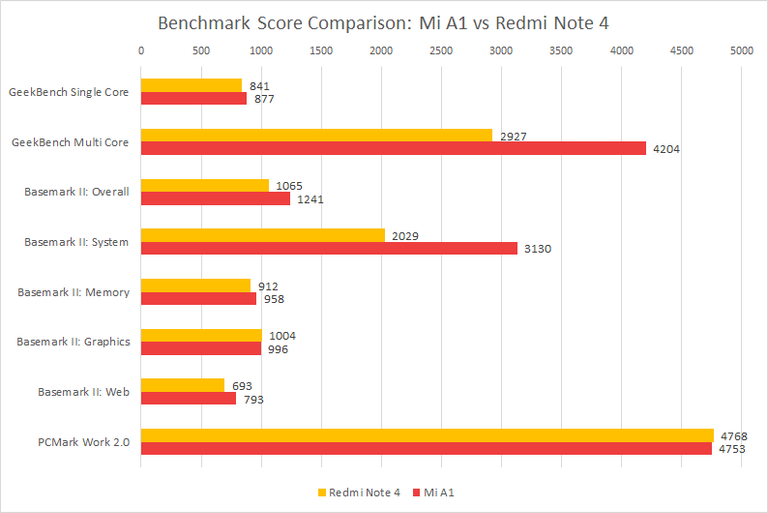
Thermal performance on the Mi A1 is excellent, and we expected nothing less from a Snapdragon 625 SoC phone. Prolonged real-world usage barely causes the phone to warm up, and the A1 remains a pleasure to use at all times, both in performance and in temperatures. The metallic body does tend to warm up when used under direct sunlight for too long, but this does not affect the performance of the device in any way either. Xiaomi claims to have used a dual graphite layer under the chassis of the A1 (but never mentioned the same for the Mi 5X, so that may be a point of hardware difference between the two) that absorbs the heat from the processor and distributes it evenly across the body — and we’d like to believe it is indeed working as the phone has no particular hot spots on the rarest of occasions that it does heat up without external sources.
Ram, Memory Management and Storage
The worst part of Xiaomi devices is their RAM and memory management due to the aggressive policies set in by MIUI. The combination of MIUI bloat applications and services, coupled with opaque “optimizations”, as well as the system’s insistence on closing down background apps beyond a certain unknown point in the interests of “battery life” — these factors mingle together to give some of the worst memory management seen in popular Android devices (but not all that uncommon among custom UX as we see similar behaviors by other OEM skins). MIUI devices greatly benefited from the increase in physical RAM, and every bit of more RAM was helpful in setting off the effects of MIUI. The biggest improvement in storage vis-à-vis the Redmi Note 4 comes in Sequential Write speeds, which have now inched closer to Sequential Read speeds on the Mi A1. This should theoretically help with video recording onto the internal storage, but you will unlikely be able to spot the difference or the improvement practically in day to day usage.
Software
The software is one of the strongest aspects of the Xiaomi Mi A1 as a differentiated product, and depending on how you look at it, it can also be called its weakest point (and we’ll come to this in a moment).The Xiaomi Mi A1 is the first device coming out of the reboot of the Android One program. Unlike every other Xiaomi phone, the Mi A1 runs stock Android 7.1.2, one that is virtually left untouched by Xiaomi. As a result, the software experience on the Mi A1 resembles that on the Google Pixels on Nougat than it does on pretty much any other Xiaomi device.And the difference in UX is striking. No longer are you greeted with Xiaomi’s heavy and often complicated UX. There are fewer bloatware applications pre-installed, there are no mysterious services running in the background, and there are fewer animations going around. You are no longer prompted to sign in with a Mi account, and you no longer need a Mi account to unlock the bootloader on this device. The entire smartphone experience feels much more familiar to people who have been following the progress of Android over the years. The launcher on the Mi A1 is Launcher3 from AOSP with Google Now integration. You get an ordinary homescreen with 5×4 icon grid per page and a 1×5 persistent dock. You can have multiple pages of homescreen, but there is no wallpaper scrolling support. The launcher does come with circular icon support, but that adds onto the icon inconsistencies and confusion with the icon shapes. You can also drop icons on top of one another to create folders on the homescreen.
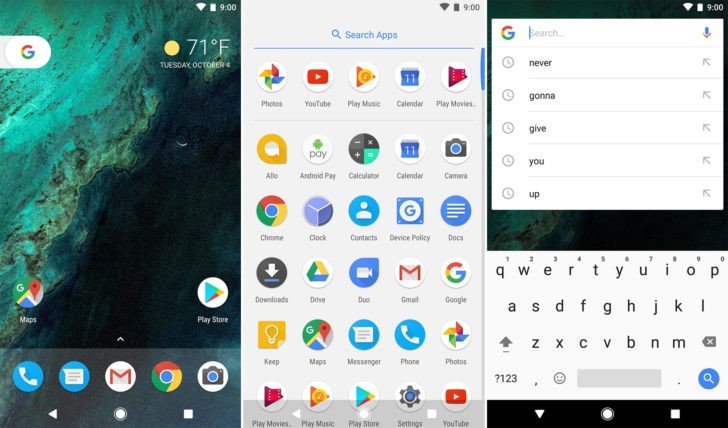
Android A/B Partition
The Mi A1 is one of those few devices that utilizes Android Nougat’s A/B Partition setup in order to provide seamless updates. And that’s it for the extras. The software experience on the Mi A1 focuses on Google’s services instead of those from Xiaomi. There are more pre-installed Google Apps than there are Xiaomi apps, and that says something just by itself. The focus on Google services, such as the fixed Google Search bar on the homescreen, points to Google’s push with Search and Google Assistant, a push the company needs in developing markets. But with the different accents, languages and regional variations existing in India; and the fairly limited scope of what can be done with Assistant in India, there is not a whole lot of incentive to adopt Assistant as hard as Google is pushing it.MIUI’s defining characteristic is certainly its different approach to Android, but that does not take away from several of the feature additions that Xiaomi has made over the years to its UX. Several key features have been received with great enthusiasm by the Indian audience, augmenting the use cases of the average urban Indian even though they may not be entirely unique in their approach.
Camera
The Xiaomi Mi A1 spices things up in the camera department by opting for a 12MP dual rear camera sensor setup. The primary shooter is a OmniVision OV12A10* sensor with wide angle 27mm lens and f/2.2 aperture. The other camera bears the telephoto 54mm wide f/2.6 lens. The setup appears similar to the flagship Mi 6’s, but there is no OIS at play in this case. The Xiaomi Mi A1 impresses in this regard when taking into account its selling price, but it does naturally disappoint when you put it against the likes of the OnePlus 5 and the iPhone 7 Plus like Xiaomi did frequently in their launch event. The camera consisted of a big portion of their selling pitch, and while we do agree that they did oversell the camera by a good margin, the results are quite appreciable compared to the Redmi Note 4 and other previous Redmi Note phones. Since the stock camera app does not support dual cameras just yet, Xiaomi had to resort to shipping the MIUI camera application on this Android One device. The interface will be familiar to anyone who has used a MIUI device in the past.
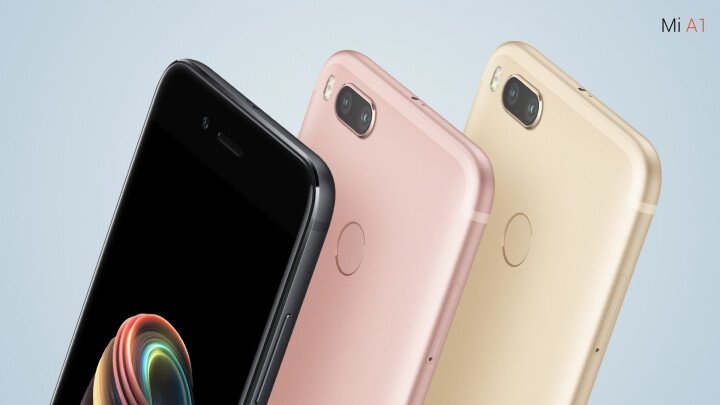
The MIUI camera app is quick to launch, and presents you with a standard camera interface that is easy to use and figure out. The shutter button and the shortcuts to the Gallery App (in this case, Google Photos) and Video Recording mode sit on the right of the viewfinder, while a few other controls and settings are presented on top of the viewfinder. You can toggle HDR mode, Portrait mode, flash, and switch between 2x and 1x zoom with these buttons. You can even dive into options to choose from a few different shooting modes and you can try out filters with live preview as well.


In the video department, the Xiaomi Mi A1 one ups the Redmi Note 4 by offering 4K video recording at 30fps. The phone does still lack OIS and EIS, so videos do come out shaky as one would expect. But the captured video was good for an early mid-ranger in 2017 with accurate colors and a wide dynamic range. You can also opt for slow motion 720p@120fps video recording, but the videos recorded are not slowed down properly even with the minimum available speed setting in post-editing — it just appears shoddy and ruins all the “wow factor” of slow motion. Wrapping up, the overall experience with the camera has been pleasant. Xiaomi claimed to compete against the likes of the iPhone 7 Plus in this department, and it really doesn’t by a good margin. But when we consider its price, the Mi A1 may easily be Xiaomi’s best camera smartphone in that price range. Other competitors like the Moto G5S Plus could have an advantage (as we cannot make a definitive statement without using the device ourselves), but the Mi A1 puts in an effort to let itself be known as a good camera smartphone in the mid-end segment. If you are limited on budget and want a smartphone that can take photographs, the Mi A1 does check that box.
Display
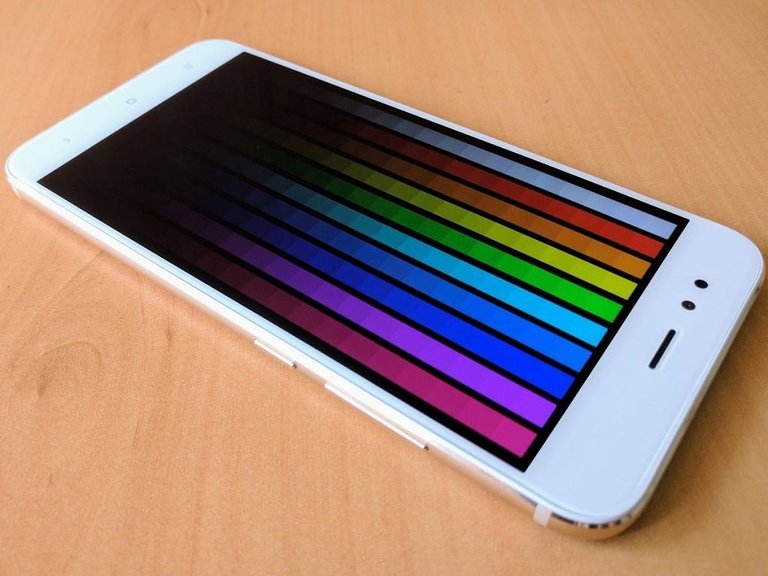
The Xiaomi Mi A1 comes with a standard 5.5” IPS LCD display with FHD 1080×1920 resolution. This is nothing new for Xiaomi or other OEMs in this price range, and you will have nothing to complain about considering the device’s price point. Just like every other Xiaomi smartphone, the display on the Mi A1 can get very bright on its maximum setting, and very dim on its minimum. This gives you the flexibility to use the device outdoors on a sunny day as well as in pitch black conditions. Color reproduction does suffer in the minimum setting, but that is expected as it caters to a very specific use case of pitch black use — you will not see anything on the display if you try to use this under lit environments. Since the phone utilizes stock Android, you can find the option to enable sRGB mode in Developer Options. The default display calibration settings should suit most users, and if it doesn’t, sRGB is as accurate as you can get on this device.
Audio
The Xiaomi Mi A1 claims to be an upgrade over a lot of other smartphones in this range when it comes to audio performance. Xiaomi claims that the Mi A1 comes with a dedicated 10V output power to the headphone jack; whereas smartphones in this price range usually come with variable output levels hovering around ~2V.The higher output helps the Mi A1 drive equipment with higher impedance to louder levels without distorting the sound or receiving feeble output. The existence of the 10V output power is not noticeable when used with earphones with 32Ω of impedance — the audio gets very loud and the sound output is great. But the same was possible with the Redmi Note 4 as well, so you are unlikely to experience any changes with earphones. Xiaomi claims that the Mi A1 can drive speakers and headphones with impedance as high as 600Ω, so this is where you will experience most of the changes. Unfortunately, we do not have access to high impedance audio equipment, so this part remains untested as far as Xiaomi’s claims go.Just like the headphone jack, the audio through the speakers gets sufficiently loud and does not lose clarity to distortion on the highest settings. The earpiece also performs satisfactorily for calls.
Battery Life and Charging
Battery life is one area where the Xiaomi Mi A1 is a significant downgrade from the Redmi Note 4. And that is understandable, because the Mi A1 opts for a smaller 3080mAh battery in order to shave off a few millimeters of thickness. But the Redmi Note 4 was an exception to the battery wars, so the Mi A1’s dwarfed performance still ends up being comparable across other smartphones in this price range. PCMark’s Work 2.0 battery benchmark gave the Mi A1 a good 6h of battery life at maximum brightness, indicating a theoretical maximum of 6hrs of looped benchmark performance at peak brightness. The device gets a score of 12h 31m under minimum brightness. While these benchmark scores do not redefine our expectations of smartphone battery life, they do indicate that the Mi A1 can last a day on most typical use cases.
Charging on the Mi A1 takes about 2 hours to go from a dead device to 100% with the included 5V/2A charging brick. There is no mention of any Quick Charge support on the Mi A1, even though the Qualcomm Snapdragon 625 supports Quick Charge 3.0. As a silver lining, the Mi A1 does come with a USB Type-C port, so at least you can insert the cable the correct way in the first time. 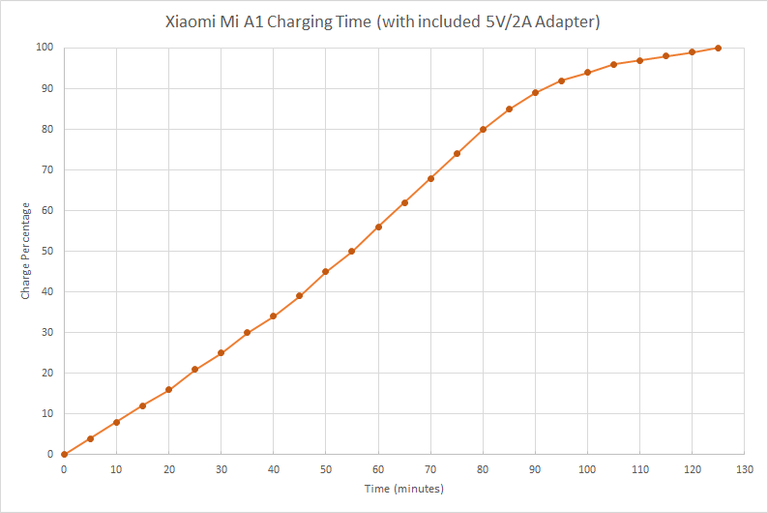
Development and Future Updates
The Mi A1 comes with Android 7.1 Nougat out of the box, but the update to Android Oreo has been promised by Google and Xiaomi before the end of this year. The Mi A1 will also be among the first set of devices that will receive the Android P update when the same becomes publicly available (not through developer previews). This makes the Xiaomi Mi A1 perhaps the first device and only device in the price range that can boast of an imminent Android P update at this stage. So the Mi A1 comes off very strong on the official update scenario, presenting us with a promised update from the very parents of Android. Unless other OEMs also release Android One devices in this range, or Google itself goes in for a Nexus/Pixel device in this price range (unlikely), the Mi A1 is the best device to purchase if you care about official Android updates in the early mid-range. Root does exist for the device, even without a recovery, ironically thanks to the A/B partition. Once you have received an update on your device, you can use the A/B slot features to switch slots to the old one, root the new one and then boot back into it. Do note, since it is not otherwise noted by Xiaomi for the A1, it is safe to assume that unlocking the bootloader and rooting the device will void your warranty.Overall, the situation on the Mi A1 is optimistic. Unlike the Redmi Note 3 and Redmi Note 4 which received an overwhelming response in the development community despite Xiaomi’s convoluted unlocking practices, the Mi A1 is off to a softer start. But since you already have AOSP and root, the prime reason to root the Redmi Notes, are you really losing out on more?

Other Analysis
FM Radio
The Xiaomi Mi A1 does not come with any FM Radio app, nor can you access it with a third party app, but it does support FM Radio functionality. You can use FM Radio through the service mode menu on the phone. Plug in your earphones and enter *#*#6484#*#* to enter service mode, where you will find FM Radio as one of the last options in the list. Select and scan for stations — you’re good to go. The problem is that this is not a full-fledged app, so your expectations have to be grounded. The functionality clearly exists, and we see FM Radio apps on all other Xiaomi phones with MIUI, so we hope Xiaomi comes to an arrangement with Google to ship one more app to allow users to access FM Radio.
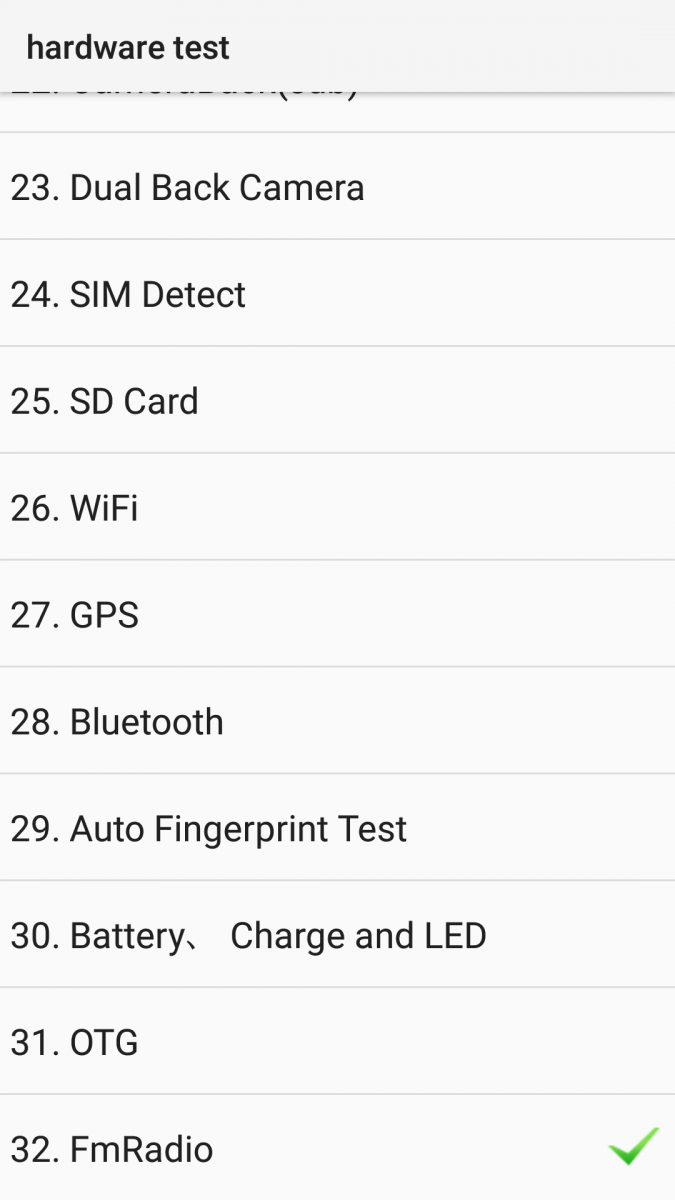
Lack of NFC
The Mi A1 with its initial launch is targeting developing markets like India and other Southeast Asian nations. As such, Xiaomi decided against including NFC on the device, much like how it skips out on several other phones in its lineup.As an Indian user, I have used NFC a grand total of zero times in the past 4 years. The exclusion of NFC will not affect a vast majority of Indian users as there simply are no use cases in the country. While NFC can be used for file-sharing and other purposes, several better solutions exist for those scenarios. So we wouldn’t fault Xiaomi for choosing to ship without NFC on this particular phone keeping in mind the budget and the target audience. If you are an avid user of NFC, the Mi A1 will not be a good choice for you.
XIAOMI A1 CONCLUSION
The Xiaomi Mi A1 marries Xiaomi’s top notch hardware and value proposition with Google’s fluid and unadulterated Android experience. The phone does away with one of the biggest complaints of Xiaomi devices and replaced it with something that many enthusiasts craved for. The cherry on top is the promise of fast updates, backed by Google themselves, a boast-worthy selling point that is unparalleled in this price range. As an Android purist, the Xiaomi Mi A1 hits a clean home run for me. Outside of the 4G network issue, I thoroughly enjoyed my time with the Mi A1. The Mi A1 is a phone that I can freely recommend to all those who do not like MIUI but still want a Xiaomi device — and there are plenty of us around who do want that. For $230, you would be hard pressed to find a more convincing package in the countries where the Mi A1 is officially sold. Yes, the device does miss out on crucial LTE bands that render it unusable in several western countries; but that argument is hollow as the phone is not sold officially in those nations.
THAT'S ALL. THANK YOU.
PLEASE UPVOTE AND RESTEEM.
Love, Respect and Peace
Saurav Shah